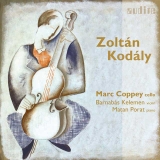Die wesentlichen Kammermusikwerke für das Cello von Zoltan Kodaly hat der aus Straßburg stammende Marc Coppey zusammen mit Freunden für eine randvolle CD eingespielt. Dabei unterstützt ihn Barnabas Kelemen auf der Violine im Duo und in den Werken mit Klavier Matan Porat. Neben dem Duo sind dies die Solosonate, die Sonate mit Klavier und noch ein Lento mit Klavier.
Coppey spielt gleich in der Solosonate herausfordernd direkt, so dass seine Interpretation den Zuhörer mit ihrer Intensität anspringt. Das ergibt eine Sichtweise, die man nicht nebenbei abtun kann. Man wird als Zuhörer sofort eingesogen ins Geschehen. Diese Qualität des Herangehens kann Coppey die gesamte Strecke über überzeugend halten. In der Sonate mit Klavier lässt er der einleitenden Fantasia einen weiten Raum der Entfaltung und Ruhe, der im Vergleich zum Vorhergehenden entspannt klingt und sich erst im Laufe des Satzes wieder etwas aufbaut. Ob das anschließende Adsagio einmal als weiterer Satz zu der nur zweiteiligen Sonate gedacht war, wird sich nicht nachvollziehen lassen. Aber auch als Einzelsatz mit der ausgreifenden, an das Cymbal erinnernden Klaviereinleitung und Bezügen zur Volksmusik der ungarischen Heimat entfaltet Kodaly seine ebenso persönliche wie auch heimatgebundene Stimme. Das Duo, das nicht nur mit technischen Hürden, sondern auch spielfreudigen Szenen garniert ist, schließlich bietet den reizvollen Abschluss. Auch hier sind Kelemen und Coppey sich in der gepflegt zugreifenden Herangehensweise einig und es gelingt ihnen, die modernen Seiten der Komposition hervorzuheben.
The essential chamber music works for cello by Zoltan Kodaly have been recorded by Marc Coppey, a native of Strasbourg, together with friends for a brimming CD. He is supported by Barnabas Kelemen on the violin in the Duo and Matan Porat in the works with piano. Besides the Duo, these are the Solo Sonata, the Sonata with piano and another slow piece with piano.
Coppey’s playing is challengingly direct right from the Solo Sonata, so that his interpretation jumps at the listener with its intensity. This makes for a point of view that cannot be ignored. As a listener, one is immediately sucked into the action. Coppey is able to maintain this interpretative quality convincingly throughout the entire track. In the Sonata with Piano, he allows the opening Fantasia a wide space of development and tranquility, sounding relaxed compared to the preceding and only building up a bit in the course of the movement. Whether the subsequent Adagio was once intended as a further movement to the sonata, which is only in two parts, will be impossible to ascertain. But even as a single movement, with its expansive piano introduction reminiscent of the cymbal and references to the folk music of the Hungarian homeland, Kodaly unfolds his voice, which is as personal as it is tied to his country. Finally, the Duo, garnished not only with technical hurdles but also scenes of joyful playing, provides the delightful conclusion. Here, too, Kelemen and Coppey are united in their cultivated approach, and they succeed in bringing out the modern sides of the composition.






















